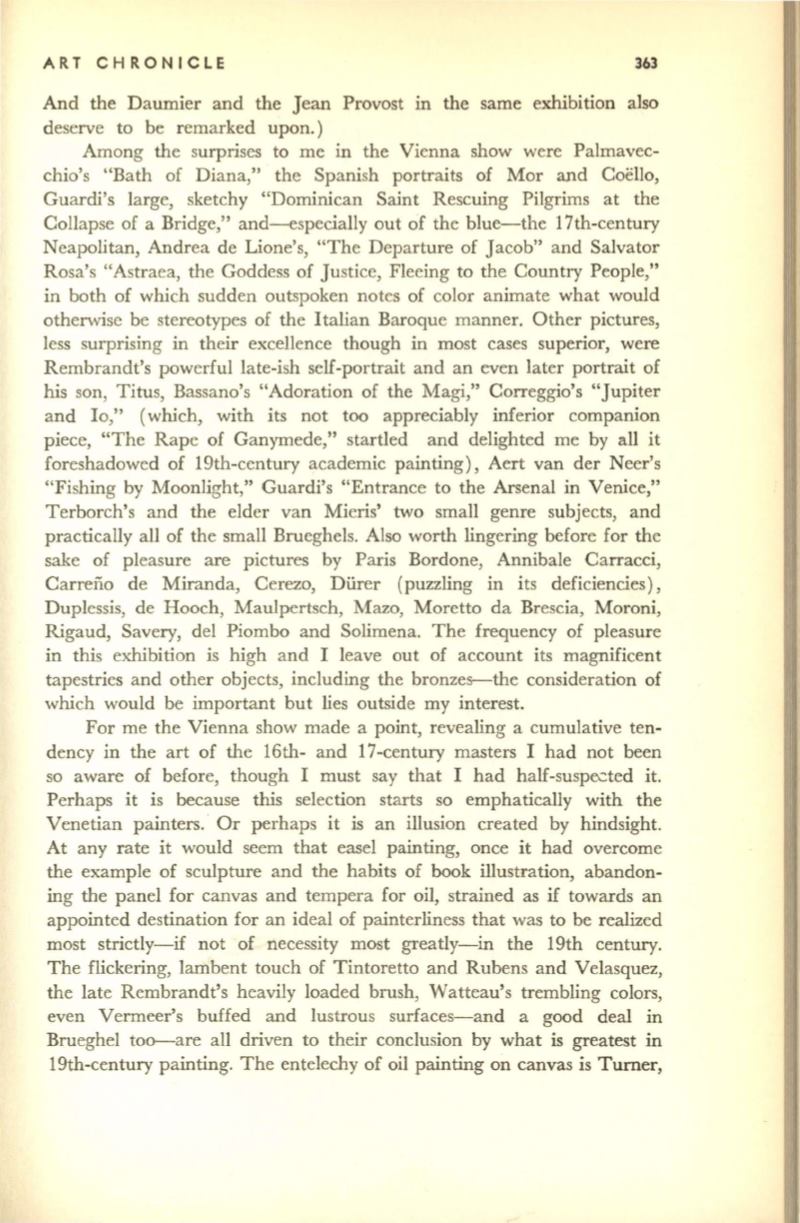
ART CHRONICLE
363
And the Daumier and the Jean Provost
in
the same exhibition also
deserve to be remarked upon.)
Among the surprises to me
in
the Vienna show were Palmavec–
chio's "Bath of Diana," the Spanish portraits of Mor and Coello,
Guardi's large, sketchy "Dominican Saint Rescuing Pilgrims at the
Collapse of a Bridge," and-especially out of the blue-the 17th-century
Neapolitan, Andrea de Lione's, "The Departure of Jacob" and Salvator
Rosa's "Astraea, the Goddess of Justice, Fleeing to the Country People,"
in both of which sudden outspoken notes of color animate what would
otherwise be stereotypes of the Italian Baroque manner. Other pictures,
less surprising in their excellence though in most cases superior, were
Rembrandt's powerful late-ish self-portrait and an even later portrait of
his son, Titus, Bassano's "Adoration of the Magi," Correggio'S "Jupiter
and
10,"
(which, with its not too appreciably inferior companion
piece, "The Rape of Ganymede," startled and delighted me by all it
foreshadowed of 19th-century academic painting), Aert van der Neer's
"Fishing by Moonlight," Guardi's "Entrance to the Arsenal in Venice,"
Terborch's and the elder van Mieris' two small genre subjects, and
practically all of the small Brueghels. Also worth lingering before for the
sake of pleasure are pictures by Paris Bordone, Annibale Carracci,
Carreno de Miranda, Cerezo, Durer (puzzling in its deficiencies),
Duplessis, de Hooch, Maulpertsch, Mazo, Moretto da Brescia, Moroni,
Rigaud, Savery, del Piombo and Solimena. The frequency of pleasure
in this exhibition is high and I leave out of account its magnificent
tapestries and other objects, including the bronzes-the consideration of
which would be important but lies outside my interest.
For me the Vienna show made a point, revealing a cumulative ten–
dency in the art of the 16th- and 17-century masters I had not been
so aware of before, though I must say that I had half-suspected it.
Perhaps it is because this selection starts so emphatically with the
Venetian painters. Or perhaps it is an illusion created by hindsight.
At any rate it would seem that easel painting, once it had overcome
the example of sculpture and the habits of book illustration, abandon–
ing the panel for canvas and tempera for oil, strained as if towards an
appointed destination for an ideal of painterliness that was to be realized
most strictly-if not of necessity most greatly-in the 19th century.
The flickering, lambent touch of Tintoretto and Rubens and Velasquez,
the late Rembrandt's heavily loaded brush, Watteau's trembling colors,
even Vermeer's buffed and lustrous surfaces-and a good deal in
Brueghel too-are all driven to their conclusion by what
is
greatest in
19th-century painting. The entelechy of oil painting on canvas is Turner,


